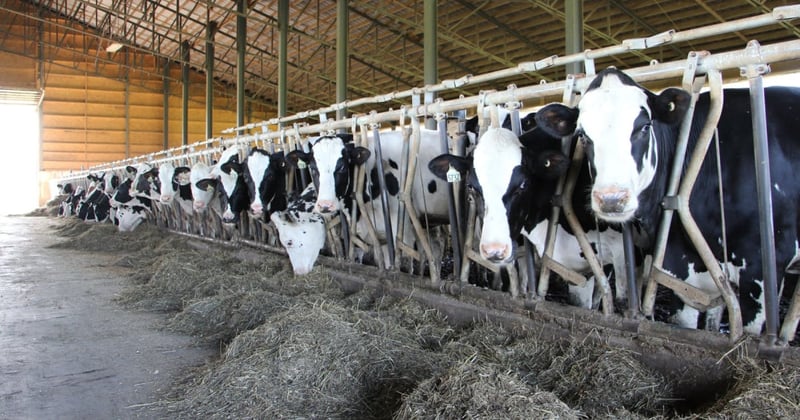
Dairy cows used for milk production in factory farms experience relentless suffering in a system that exploits them. You have a choice not to support the cruelty.
A dairy cow’s ordeal
There are over 265 million dairy cows worldwide, producing nearly 600 million tonnes of milk every year. A cow would naturally produce around 1,000 litres of milk for her calf over ten months The average milk production in intensive production systems is 10,000 litres per cow, but a significant proportion of cows produce up to 20,000 litres per year.1 Milk production per cow has more than doubled in the past 40 years.2 In the factory farming system, cows are treated as milking machines, suffering at every step of their tragically short lives.
Life as a milk machine
For their bodies to produce extraordinary amounts of milk each day, dairy cows are fed concentrated nutrient-dense food, as their natural diet of foraging and grazing simply can’t meet their bodies’ needs. This unnatural diet can cause a metabolic condition called acidosis, resulting in diarrhoea and laminitis (damage to their feet that causes lameness).3
Most dairy cows will be kept indoors for part or all of the year. Some are confined to crowded conditions with cold, bare, hard floors,4 poor ventilation, sudden or loud noises, and difficulties accessing food and water. Cows who are kept on concrete floors with inadequate bedding are also more likely to develop mastitis (painful inflammation and infection of their udders).5
Dairy cows are forced to give birth once a year, so that they can produce milk for most months of the year. Cows are usually artificially inseminated within three months of giving birth, so the cruel cycle begins again.6
This all takes such a toll on their bodies that they are worn out and sometimes infertile after just three births.7 At around five and a half years old they slaughtered.8 This is in stark contrast to the twenty years of life a cow may naturally have.
Born to suffer
Naturally, calves suckle from their mothers for up to a year and may maintain a strong bond with her. However, on factory farms calves are taken from their mothers within hours of birth, causing severe distress to both the cow and the calf. Because calves are separated so soon from their mothers, they often do not get enough colostrum (the “first milk”) which is crucial in helping calves develop a strong immune system. Calves normally suckle milk several times a day from their mother, but on factory farms they may only be fed twice a day, often with milk replacers rather than cow’s milk, which can lead to digestive disorders and ulcers.9
Most female dairy calves are doomed to live the same short, miserable as their mothers as the cycle continues. Males are considered surplus since they have no production value on dairy farms.10 Sadly, they may be either shot at birth or exported to low welfare veal farms.
Calves destined for the meat industry can be transported for several days over long distances. They may only be one week old - hungry, tired, scared, and vulnerable to disease and injury.11 Those who survive the journey are often kept in terrible conditions and slaughtered within months.12
You can choose not to support the cruelty of the factory farming industry by incorporating more plant-based foods in your diet and saying 'yes' to less meat and dairy.
References
1 Compassion in World Farming (2020) Is the next pandemic on our plate? Our food system, through the lens of COVID-19 Is the next pandemic on our plate? | Compassion in World Farming (ciwf.org.uk)
2 https://www.ciwf.org.uk/farm-animals/cows/dairy-cows/
3 Sub-acute Ruminal Acidosis (SARA) and its Consequence in Dairy Cattle: A Review of Past and Recent Research at Global Prospective https://www.sciencedirect.com/science/article/pii/S2078152016300773
4 Animal Welfare Committee Opinion on the welfare of cattle kept in different production systems https://www.gov.uk/government/publications/awc-opinion-on-the-welfare-o…
5 https://www.ciwf.org.uk/farm-animals/cows/dairy-cows/
6https://www.ciwf.org.uk/farm-animals/cows/dairy-cows/
7https://www.ciwf.org.uk/farm-animals/cows/dairy-cows/
8 Compassion in World Farming (2020) Is the next pandemic on our plate? Our food system, through the lens of COVID-19 Is the next pandemic on our plate? | Compassion in World Farming (ciwf.org.uk)
9 Animal Welfare Committee Opinion on the welfare of cattle kept in different production systems https://www.gov.uk/government/publications/awc-opinion-on-the-welfare-o…
10https://www.ciwf.org.uk/farm-animals/cows/dairy-cows/
11 UK Calf Transport and Veal Rearing https://www.ciwf.org.uk/media/3818647/uk-calf-transport-and-veal-rearin… 12 https://www.ciwf.org.uk/farm-animals/cows/dairy-cows/
Make a difference. Join our community.
We campaign to improve animals' lives in the UK and around the world. Why not join us today?
Dairy cows are forced to give birth once a year so that they can produce milk for most months of the year. Cows are usually artificially inseminated within three months of giving birth, so the cruel cycle begins again.